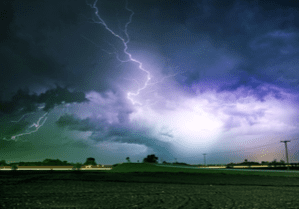Nobody expects an emergency or disaster to strike, but it can certainly happen at any given time. No matter where you are, it’s important to be aware of severe weather alerts in real-time and respond appropriately. One way to do this is to set up free weather alerts on your smartphone.
Weather Emergency Alerts (WEA) are sent by authorized government agencies, alerting authorities through your mobile carrier. Government partners include FEMA, the FCC, the Department of Homeland Security, the National Weather Service, and local and state public safety agencies. These alerts can help inform you of hazardous weather conditions and emergencies and advise you on the proper precautions you should take. Unlike a regular text message, WEAs include a special loud tone and vibration, both repeated twice.
Most wireless devices available since 2012 automatically have the capability to send you WEAs. You do not need to sign up or subscribe to these alerts, but you do need to ensure that your phone is enabled to share them with you. Here are some instructions to set up these free weather alerts and steps you should take when you receive one.
How to Set Up Free Weather Alerts on Your Phone
If you have an iPhone:
- Tap “Settings” and then “Notifications.”
- Scroll to “Government Alerts” towards the bottom of the screen.
- Turn on “Emergency Alerts” and “Public Safety Alerts” by sliding the circle to the right of the screen. If the circle turns green, this means that the alerts have been enabled successfully.
The steps vary for Android phones, but here are the basic instructions for a Google Pixel phone:
- In “Settings,” find “Apps and Notifications.”
- Tap “Notifications.”
- Next, turn on “Allow Alerts.”
- Make sure you turn on the alerts for “Extreme Threats,” “Severe Threats,” “Public Safety Messages,” and “State and Local Tests” by sliding the circle to the right of the screen. If the circle turns light blue, this means that the alerts have been enabled successfully.
What to Do When You Receive a WEA?
There are many steps you can take in the event of severe weather. After receiving one of these free weather alerts, here are some general safety practices to consider, depending on the circumstances:
- Tune in to local radio or television stations for live updates and check local weather reports online for live updates. WEAs are designed to get your attention in an emergency, but they are concise and do not report every detail. For a full report, it’s best to turn to the news.
- Be prepared to take cover when the following alerts have been issued for your area:
- Severe Thunderstorm Watch – Severe thunderstorms are possible
- Tornado Watch – Tornadoes are possible
- Take immediate cover when the following warnings have been issued for your area:
- Severe Thunderstorm Warning – Severe thunderstorms are occurring.
- Tornado Warning – A tornado has been sighted or indicated by weather radar.
- If a tornado warning is issued or the weather becomes severe, seek immediate coverage in the company’s pre-designated shelter area.
- If you are unable to reach the pre-designated shelter area, take cover in rooms with few or no windows, such as restrooms, kitchens or hallways. Stay on the lowest possible floor.
- If possible, climb under heavy furniture, such as tables and desks.
- Cover your face and head with your coat or jacket to protect yourself from flying materials (e.g., glass).
- Remain safely distanced from all windows and doors.
- If you have an elderly relative or neighbor who does not have a smartphone and cannot receive WEAs, give them a call to make them aware of the emergency, once you are settled in a safe place.
Additional Alarms to Keep in Mind
Outside of your phone, you may hear a variety of alarms in your area to distinguish severe weather. Here’s a list of the different types of alarms and what they may mean:
- Audible Alarms:
- Vibrating bells usually indicate a fire alarm
- Horns are loud distinctive sounds that immediately attract attention, usually used to call a critical situation to attention.
- Sirens are loud piercing wails that are usually used to initiate a state-wide evacuation.
- Announcement systems are live or recorded voice messages played over speakers, usually used for phased or guided evacuations.
- Visual Alarms:
- Flashing or steady lights may be used in areas where ambient noise makes audible signals difficult to hear. These types of lights may come with different colored covers for increased attention and may have rotating or flashing lights.
- Strobe lights may be used in areas where high ambient light levels make traditional rotating or flashing lights difficult to distinguish or where ambient noise makes audible signals difficult to hear.
Are You Prepared to Protect Yourself?
We can’t predict when we will find ourselves in unimaginable situations, but we can prepare accordingly. Setting up free weather alerts is a start – but to protect yourself even further, set up a consultation with one of Horton’s personal insurance experts to evaluate your risks and ensure you are covered accordingly.
Material posted on this website is for informational purposes only and does not constitute a legal opinion or medical advice. Contact your legal representative or medical professional for information specific to your legal or medical needs.




